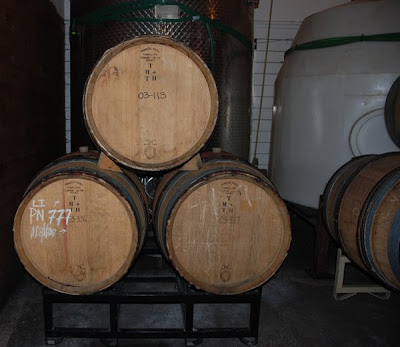We bring our wines to our eyes, noses and mouths for evaluation and enjoyment and we imagine how this wine may have been treated. When we think of oak aging, chances are that we get a picture similar to this.
Is this always what happens? Perhaps the wine industry would have us believe this. How many marketing impressions of wine have you seen that include oak dust, chips, staves, and beans? Not many and unless you are in the industry, you probably have never seen or heard of these. It would be pretty odd marketing.
Barrels like those shown come from French, American and Central European manufacturers. These barrels are becoming more and more expensive. Wineries are looking for ways to remain competitive. Competitive may mean remaining in a price point in spite of rising costs, producing a higher quality product in the price point the brand is in, or maximizing profits.
All of this is not very interesting to me as a consumer and not worth mentioning in this forum, but for one fact…barrel alternatives provide a way to provide a quality product while reducing the pressure on the forests.
Other than wood, wine is produced in stainless steel tanks, concrete tanks, and poly. They all have their merits. All of these are reusable. However it is the oak wood that imparts tannins, enhances roundness and helps stabilize color. Oak barrels also allow and exchange of oxygen in the wine.
A barrel has its strongest impact with its first use. Three times is about the max for most barrels. Thus a winery has to keep forking out for new barrels, trees get cut down and well eventually wine up somewhere as ash or trash. 
Extending barrel life
Wineries are starting to refurbish their barrels. Barrels are sent to the cooper and have their insides shaved and toasted. Thus a barrel gets a new life and the wine maker has a barrel at the fraction of the cost. This is a growing market segment for coopers.
Another method of extending a barrel’s life is to put a ring of staves inside the barrel. The cooper removes the top of the barrel and inserts a lining of new wood. This also is a cheaper alternative to new cooperage.
Other wood products
For those producers choose not to compete in a price point that will support the use of cooperage, there are alternatives and these alternatives are even finding their way into boutique wineries as well. Oak chips,flour, slats and spirals, are being used in barriques to help keep quality up without the expense of new barrels.
The skill of the winemaker must be expanded to use these materials. With oak, it’s the surface exposed to the wine in proportion to the volume of wine that is important. So the winemaker must decide if he wants to use flour with a high, almost impossible to control surface area, slats or “beans”. Beans offer a very predictable surface area and are easy to get into and out of barrels.
I am happy to see these products being used when they are used judiciously. There will always be a need for new cooperage and these products are made from the leftover lumber that is not suitable for making staves. This give a chance to produce a higher quality wines at a lower price point, barrels having longer life and there is less pressure on the forests. Seems good.
These products can be used in an attempt to mask an inferior wine. You can trick out a wine with turbo-chargers, chrome pipes, mag wheels and a Holly four-barrel, but you will still wind up with funky wine. Oak and toast will not make a bad harvest good. For a good example of this compare the 2005 and 2006 Ruffino Lumina Pinot Grigio. Flaws cannot be hidden. These interventions are a fact of the wine business. Keep it in perspective. It can bring variety to our world or it can bring homogeneity. Winemakers are using them. The marketers are spinning the dream. The public is buying.
These interventions are a fact of the wine business. Keep it in perspective. It can bring variety to our world or it can bring homogeneity. Winemakers are using them. The marketers are spinning the dream. The public is buying.
What do you think? Is the dream important?
Saturday, May 10, 2008
Oak and Living the Dream
Posted by
Taster A
at
6:56 AM
![]()
Tags wine appreciation, wine making
Subscribe to:
Post Comments (Atom)





1 comments:
Bleaugh! Oak - the bane of the California and Australian wine industry.
Post a Comment